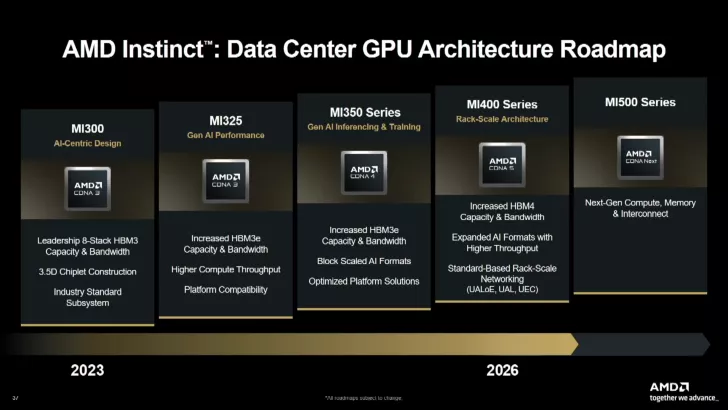As the competition in the AI accelerator market intensifies, AMD is gearing up for a head-to-head challenge with NVIDIA through its upcoming Instinct MI400 and MI500 series GPUs. These cutting-edge accelerators promise to redefine performance benchmarks and set the stage for a new era of AI developments.
AMD MI400 Series Unveiled
AMD’s MI400 series, set to launch next year, promises significant advancements with its CDNA 5 architecture. These GPUs will boast increased HBM4 capacity and bandwidth, expanded AI formats, and enhanced networking capabilities. The MI400 series is positioned to double the compute power of its MI350 predecessor, featuring 40 PFLOP (FP4) and 20 PFLOP (FP8) performance.

AMD’s MI400 GPUs are anticipated to outperform the competition in several key areas, offering 1.5 times the memory capacity and scale-out bandwidth compared to NVIDIA’s offerings. This strategic positioning highlights AMD’s ambition to dominate the AI accelerator market.
Instinct MI500 Set for 2027 Debut
Looking further ahead, the Instinct MI500 series is slated for a 2027 release. Building on the annual update cycle, these accelerators are expected to introduce groundbreaking advancements in compute, memory, and interconnect technologies, mirroring trends seen at NVIDIA. This series aims to elevate AI rack performance to unprecedented levels, thereby ensuring AMD remains a formidable force in the AI domain.
AMD Instinct AI Accelerators:
| Accelerator Name | AMD Instinct MI500 | AMD Instinct MI400 | AMD Instinct MI350X | AMD Instinct MI325X | AMD Instinct MI300X | AMD Instinct MI250X |
|---|---|---|---|---|---|---|
| GPU Architecture | CDNA Next / UDNA | CDNA 5 | CDNA 4 | Aqua Vanjaram (CDNA 3) | Aqua Vanjaram (CDNA 3) | Aldebaran (CDNA 2) |
| GPU Process Node | TBD | TBD | 3nm | 5nm+6nm | 5nm+6nm | 6nm |
| XCDs (Chiplets) | TBD | 8 (MCM) | 8 (MCM) | 8 (MCM) | 8 (MCM) | 2 (MCM) 1 (Per Die) |
| GPU Cores | TBD | TBD | 16,384 | 19,456 | 19,456 | 14,080 |
| GPU Clock Speed (Max) | TBD | TBD | 2400 MHz | 2100 MHz | 2100 MHz | 1700 MHz |
| INT8 Compute | TBD | TBD | 5200 TOPS | 2614 TOPS | 2614 TOPS | 383 TOPs |
| FP6/FP4 Matrix | TBD | 40 PFLOPs | 20 PFLOPs | N/A | N/A | N/A |
| FP8 Matrix | TBD | 20 PFLOPs | 5 PFLOPs | 2.6 PFLOPs | 2.6 PFLOPs | N/A |
| FP16 Matrix | TBD | 10 PFLOPs | 2.5 PFLOPs | 1.3 PFLOPs | 1.3 PFLOPs | 383 TFLOPs |
| FP32 Vector | TBD | TBD | 157.3 TFLOPs | 163.4 TFLOPs | 163.4 TFLOPs | 95.7 TFLOPs |
| FP64 Vector | TBD | TBD | 78.6 TFLOPs | 81.7 TFLOPs | 81.7 TFLOPs | 47.9 TFLOPs |
| VRAM | TBD | 432 GB HBM4 | 288 GB HBM3e | 256 GB HBM3e | 192 GB HBM3 | 128 GB HBM2e |
| Infinity Cache | TBD | TBD | 256 MB | 256 MB | 256 MB | N/A |
| Memory Clock | TBD | 19.6 TB/s | 8.0 Gbps | 5.9 Gbps | 5.2 Gbps | 3.2 Gbps |
| Memory Bus | TBD | TBD | 8192-bit | 8192-bit | 8192-bit | 8192-bit |
| Memory Bandwidth | TBD | TBD | 8 TB/s | 6.0 TB/s | 5.3 TB/s | 3.2 TB/s |
| Form Factor | TBD | TBD | OAM | OAM | OAM | OAM |
| Cooling | TBD | TBD | Passive / Liquid | Passive Cooling | Passive Cooling | Passive Cooling |
| TDP (Max) | TBD | TBD | 1400W (355X) | 1000W | 750W | 560W |
